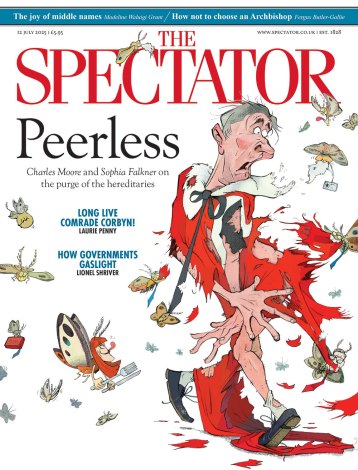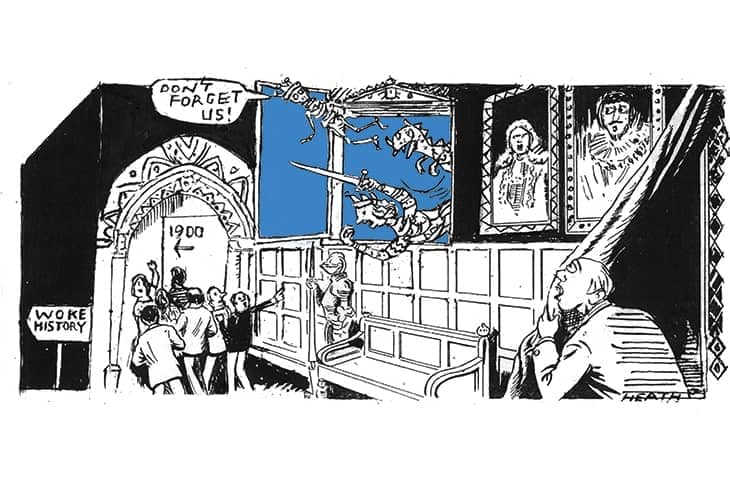On a clear day, from the balcony of Tullie House Museum & Art Gallery in Carlisle, you can see the McVitie’s factory. If the wind were in the right direction, I like to think you’d smell digestives on the breeze. Originally, it was the factory of Carr’s, bakers of table water biscuits since 1831. Carr’s held the Royal Warrant from 1841 until 2012, when it lost the crown due to ‘changing tastes’ in the royal household. I blame Duchy Originals Oaten Biscuits.
Inside the museum is a display of Carr’s covetable vintage biscuit tins and, on a satin hanger, the brown velvet waistcoat worn by Jonathan Dodgson Carr himself. The fabric is printed with ears of wheat and the tiny slogan ‘Free’. Carr, a supporter of the repeal of the Corn Laws, used to wear his waistcoat to public meetings. When the laws were repealed in 1846, he wore it to the celebratory tea put on for his Caldewgate factory workers.
It’s partly the legacy of minimalism and the cult of the white cube: imagine no possessions, it’s easy if you try
Tullie House is full of treasures, arranged according to disorder, touching on this and that and the Cumbrian other. There are weaving combs and spindle whorls and programmes for historic Carlisle United matches. (Carlisle vs Everton, 1968, ‘a true clash of the blues’; Everton won 1-0.) There is a microscope tray with an assortment of spiders and a cabinet containing the skulls of a shrew, a mouse and a vole. So small! There are bone beads and horn toggles, microliths and arrowheads, glass bangles and a rosary. There is a whistle in the form of a cockerel and a brooch in the shape of a dog. There are odd, perforated objects like Neolithic Henry Moores. There is a fierce little bronze of a satyr and a Celtic pottery god. There is a 1950s nylon dancing dress and a spar box sparkling with quartz. There is a miniature monstrance and the Muckle Toon Bell, cast around 1400 and rung whenever
raiders were sighted. Presiding over it all is the suspended skeleton of Driggsby the whale, washed up at Drigg Point, near Ravenglass, on the west Cumbrian coast in February 2014.
On the drive up to Hadrian’s Wall that afternoon, I tried to put my finger on what made Tullie House so especially pleasing. I think it’s stuff, clutter, schmutter, swag. Serendipity and superfluity. Too much to take in in one go. The element, too, of surprise. I didn’t know that I wanted to know about Wally Bird tobacco jars, named after their maker, Robert Wallace Martin; I didn’t know there was such a thing as a Wally Bird tobacco jar, but my life is enriched by their having beakily pecked their way into my presence.
Wriggling through Brampton, it struck me how bored I was by bare museums, how lazily accustomed my eye is to empty atriums. ‘Great space,’ we murmur reverentially in the concrete foyer of yet another modern art museum. Tullie House is not a great space. It is an awkward warren of a space. It is three buildings spliced together with no through routes, and staircases that take you right back round to where you started. But what a feast of things to see.
It has ten times the charm of Tate Modern’s cavernous, cheerless Switch House. The past 20 years have given us some beautiful gallery buildings. The Hepworth in Wakefield (David Chipperfield), Turner Contemporary in Margate (Chipperfield again), the Jerwood in Hastings, now Hastings Contemporary, by HAT Projects. All lovely, but low on actual pictures, curios, bits and bobs.
It’s partly the legacy of minimalism and the cult of the white cube: imagine no possessions, it’s easy if you try. The hallmark of the modern gallery is nice windows, few whatnots. The Victorians loved a whatnot. They delighted, indeed, in a piece of furniture quite literally called the whatnot: an open stand with shelves for the display of ornaments, oddities, books, bonbonnières and figurines. A whatnot for storing other whatnots.
We’re due a whatnot revival. My inbox is full of press releases for the launch of the latest many-million-pound gallery extension and revamp. What was normal in the 2000s now looks obscene in the light of the Covid shortfall in most cultural budgets. I do not wish poverty on any gallery, but if I’m playing Pollyanna, one silver lining of the pandemic might be to put a stop to the gallery space race. Hitherto the rule has been: anything you can do, the Tate can do better, bigger and at greater expense. The National Portrait Gallery is currently closed for a £35.5 million makeover. The National Gallery has drawn up a shortlist of six architects to ‘reconfigure’ the Sainsbury Wing and ‘reimagine’ the northern edge of Trafalgar Square. A winner is expected in July. Costs to be confirmed.
Coffers may be empty, but cupboards are not bare. Many galleries have hundreds, thousands and, in the case of the British Museum, millions of objects hoarded in store. Time to do a Tullie. Get your bits out for the ladies and lads.







Comments